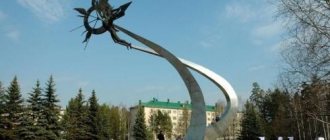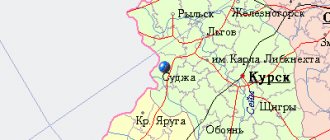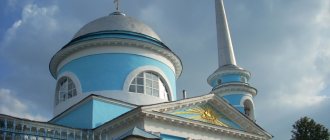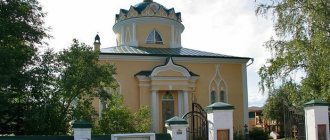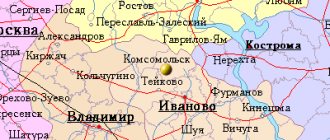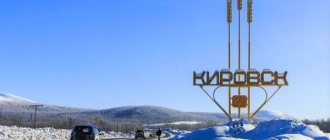This term has other meanings, see Rasskazovo (meanings).
| City Rasskazovo Flag | Coat of arms |
| A country | Russia, Russia |
| Subject of the federation | Tambov regionTambov region |
| Urban district | town of Rasskazovo |
| Coordinates | 52°40′00″ n. w. 41°53′00″ E. long / 52.66667° north w. 41.88333° E. d. / 52.66667; 41.88333 (G) [www.openstreetmap.org/?mlat=52.66667&mlon=41.88333&zoom=12 (O)] (Z)Coordinates: 52°40′00″ N. w. 41°53′00″ E. long / 52.66667° north w. 41.88333° E. d. / 52.66667; 41.88333 (G) [www.openstreetmap.org/?mlat=52.66667&mlon=41.88333&zoom=12 (O)] (I) |
| Chapter | Kolmakov Alexey Nikolaevich |
| Based | in 1697 |
| First mention | 1698 |
| City with | 1926 |
| Square | 36.12 km² |
| Center height | 150 |
| Population | ↘44,180[1] people (2016) |
| Density | 1223.15 people/km² |
| Names of residents | storyteller, storyteller |
| Timezone | UTC+3 |
| Telephone code | +7 47531 |
| Postcode | 393250 |
| Vehicle code | 68 |
| OKATO code | [classif.spb.ru/classificators/view/okt.php?st=A&kr=1&kod=68425 68 425] |
| Official site | [g31.tambov.gov.ru/ bov.gov.ru] |
| Rasskazovo Moscow |
| Tambov Rasskazovo |
K: Settlements founded in 1697
Raskazovo
- a city (since 1926[2]) in Russia, the center of the Rasskazovsky district of the Tambov region. Is a city of regional subordination; founded - as a rural settlement - in 1697[3].
Located in the central part of the Oka-Don (Tambov) plain, on the Lesnoy Tambov River (right tributary of the Tsna), at the confluence of the Arzhenka River: 10 km from the South-Eastern Railway Platonovka railway station, and approximately the same distance from the former Rasskazovo station (currently closed; now it is the Rasskazovo stopping point on the Rada - Platonovka section, 40 km east of Tambov).
City `s history
At the turn of the 17th-18th centuries, large villages arose on the territory of the present Rasskazovsky district: Rasskazovo, Verkhnespasskoye, Koptevo, Podosklyai, Nizhnespasskoye, Sayukino, Dmitrievshchina, Tatarshchino, in the 18th century - Nikolskoye, Rozhdestvenskoye, Khitrovo, Akhtyrka, Kobylinka (Kotovskoye), Znamenka, Osinovka, Novgorodovka (Betiny farm), Alekseevka, Lipovka, Kersha, in the 19th century - Picher, Platonovka, Ivanovka, Kamennye Ozerki, Teleshovka, Bogoslovka, Mozharovka, Nadezhdino.
Village Rasskazovo
known since 1697[4]; then the Morshan peasant Stepan Andreevich Rasskaz (Vodyanov) received a royal charter to found this settlement. The first inhabitants of the village were mainly peasants from the Tambov villages of Kulikovo and Morsha.
In the 18th - early 20th centuries, Rasskazovo was famous for its handicraft industries: knitting stockings, tanning leather, producing candles and soap. The sheepskin and fur trade was developed in the surrounding villages. By 1744, the Demidov distillery was operating. In 1754, factory production of cloth arose in Rasskazovo - at the factory of Tulinov and Olesov.
In 1774, near the village, tsarist troops defeated the rebel detachment of Ataman Ivan Kirpichnikov.
At the end of the 18th century, Emperor Paul I granted about three thousand village peasants to the Arkharov brothers - Ivan and Nikolai. The cloth factory of I.P. Arkharov in Rasskazov was then one of the largest in Russia. In the middle of the 19th century, there were cloth factories here: Arkharov, Ragozy (Arzhen factory), Malin and Poltoratsky factories (Bogoslovsky factories), 60 tanneries, two potash factories, a fair, a bazaar, and a postal station. There was an active grain trade, which noticeably weakened after the construction of the Tambovo-Kamyshinskaya railway line; At this time, the main items of trade were cattle, raw leather, and locally produced boots.
By the end of the 19th century, Rasskazovo was a large commercial and industrial center of the Tambov province (four cloth factories, a felt establishment, a distillery, as well as small tanneries, a soap factory, a steam mill and other enterprises). In total in 1913 there were about six thousand workers.
At the beginning of the 20th century there was also a postal and telegraph office, a telephone network, a zemstvo hospital, hospitals at the factories of the Aseev and Munda brothers, an emergency room at the Zheltov factory, a pharmacy, shelters for orphans and the elderly, Medvedev's electric theater, a network of zemstvo, parish and factory schools Since the 19th century, Rasskazovo has been a major center of Orthodox sectarianism: Christian Believers (Khlysty), Molokans, Subbotniks.
At the end of the 19th and beginning of the 20th centuries, Rasskazovo was one of the centers of musical life in the province (I. Kryuchenkov’s choir, the Aseev brothers’ theater).
Rasskazovo has had the status of a city since 1926.[5]
The modern city of Rasskazovo is an industrial satellite city of Tambov.
Population of Rasskazov for 2022. Number of inhabitants of Rasskazov
Data on the number of city residents are taken from the Federal State Statistics Service. Official website of the Rosstat service www.gks.ru
. The data was also taken from the unified interdepartmental information and statistical system, the official website of EMISS www.fedstat.ru. The website publishes data on the number of residents of Rasskazov. The table shows the distribution of the number of residents of Rasskazov by year; the graph below shows the demographic trend in different years.
Source
Industry
Throughout its history, Rasskazovo developed primarily as a center of agricultural production. The most famous agricultural enterprise is Gosplempttice.
In the 1990s. many enterprises in the city (especially those related to light industry: the production of woolen fabrics, leather production) either completely disappeared or sharply reduced production volumes[21].
Currently, the main enterprises include:
- Tannery
- Biochemical plant
- Spetsstroymashremont
- Metal structures plant "SVS-Tekhnika"
- Plempttice
- Rasskazovsky Electrotechnical Plant
There are knitting shops of private entrepreneurs and enterprises producing workwear from cloth. Currently, the Arzhensky Cloth Factory, the Rasskazovsky Knitwear factories, the Russian-Yugoslav joint venture Rasskazzovo-Invest (leather goods), Rameako (fur and fur coats) operate here; factories - heavy-duty vehicles "Altkam", "Remattra" (special vehicles, trailers), "Kozhevnik", biochemical, low-voltage equipment "Eltra"; dairy, beer, bakery and confectionery factories.[22]
Population[ | ]
| Population | |||||||||||
| 1897[10] | 1926[10] | 1931[10] | 1939[10] | 1959[11] | 1967[10] | 1970[12] | 1979[13] | 1989[14] | 1990[15] | 1991[15] | 1992[15] |
| 12 000 | ↗25 000 | ↗26 600 | ↗30 800 | ↗33 785 | ↗37 000 | ↗40 038 | ↗43 585 | ↗49 058 | ↗50 800 | ↘50 700 | ↘50 500 |
| 1993[15] | 1994[15] | 1995[15] | 1996[15] | 1997[15] | 1998[15] | 1999[15] | 2000[10] | 2001[10] | 2002[16] | 2003[10] | 2005[10] |
| ↘50 400 | ↘50 200 | ↘50 000 | ↘49 900 | ↘49 500 | ↘49 000 | ↘48 700 | ↗49 300 | ↘48 800 | ↘46 516 | ↘46 500 | ↘45 500 |
| 2006[10] | 2007[10] | 2008[10] | 2009[17] | 2010[18] | 2011[10] | 2012[19] | 2013[20] | 2014[21] | 2015[22] | 2016[23] | 2017[24] |
| ↘45 000 | ↘44 600 | ↘44 400 | ↘44 245 | ↗45 484 | ↗45 500 | ↘45 138 | ↘44 996 | ↘44 928 | ↘44 760 | ↘44 180 | ↘43 758 |
| 2018[25] | 2019[26] | 2020[27] | 2021[1] | ||||||||
| ↘43 330 | ↘42 767 | ↘42 679 | ↘42 293 | ||||||||
As of January 1, 2022, in terms of population, the city was in 364th place out of 1,116[28]cities of the Russian Federation[29].
Monuments
- Church of St. John the Evangelist (1879)
- Church of St. Catherine, 1893 with factory hospital and shelter
- The palace and park ensemble of the former estate of the Aseev factory owners (1906). In 2011, reconstruction began.
- the remains of the estate of the noble Poltoratsky family, close friends of A. S. Pushkin[23] (most of the estate was demolished in 2014)
- park-estate of the Arkharov brothers (burnt down on October 10, 2015)
- the remains of factory architecture of the 18th-20th centuries: the cloth factories of Tulinov, Malin, Ragoza, Poltoratsky, Aseev, the Kryuchenkov distillery (the old factories have already been mostly dismantled for building materials and metal).
- merchant, trade, school, sectarian, administrative buildings of the 18th-20th centuries (recently they have been massively demolished and rebuilt)
4 km south of Rasskazovo there is an island section of the forest “Soulless Bush” (an area of over 100 hectares), on the territory of which part of the ancient Astrakhan salt tract has been preserved. According to legend cited by historians S.A. Bereznegovsky (1797-1868)[24] and I.I. Dubasov (1843-1913)[25], E.I. Pugachev’s troops were hiding in this forest.
Geography[ | ]
Physico-geographical location[ | ]
Located in the central part of the Oka-Don (Tambov) plain, on the Lesnoy Tambov River (right tributary of the Tsna), at the confluence of the Arzhenka River: 10 km from the South-Eastern Railway Platonovka railway station, and approximately the same distance from the former Rasskazovo station (currently closed; now it is the Rasskazovo stopping point on the Rada - Platonovka section, 40 km east of Tambov).
Time zone[ | ]
The city operates on Moscow time, time zone MSK (UTC+3)[8].
Climate[ | ]
The city has a temperate continental climate, with moderately cold, snowy winters and warm, fairly humid summers. The minimum amount of precipitation falls in March and averages 31 mm. The greatest amount of precipitation falls in July - an average of 67 mm. The hottest month of the year is July, with an average temperature of +20.2 °C. The coldest month is January with an average temperature of −9.8 °C[9].
Famous people
- Sergeev-Tsensky, Sergei Nikolaevich - writer
- Markov, Moisei Aleksandrovich - physicist, academician of the Russian Academy of Sciences
- Cherkasov Evgeny Aleksandrovich - lieutenant, commander of battery No. 19 BM-13 (Katyusha) in the 19th Army of the Western Front [26]
- Lenkov Alexander Sergeevich is a Soviet and Russian theater and film actor. People's Artist of Russia (1997)
- Komyagin, Alexander Valerievich - Hero of the Russian Federation
- Ovchinnikov, Vyacheslav Viktorovich - Russian military leader, Colonel General, Doctor of Law
- Popov, Boris Petrovich - Hero of the Soviet Union
- Guseva Klara Ivanovna is an Olympic champion in speed skating, born[27] in the village of Picher (the source erroneously says “Pichersk”), Rasskazovsky district.
Notes[ | ]
- ↑ 12
The permanent population of the Russian Federation by municipalities as of January 1, 2022 (Russian). Retrieved April 27, 2022. Archived May 2, 2022. - THE USSR. Administrative-territorial division of the union republics on January 1, 1980 / Comp. V. A. Dudarev, N. A. Evseeva. - M.: Izvestia, 1980. - 702 p. — P. 227.
- Charter of the city of Rasskazovo
- Will sturgeons return? // City portal www.rasskazovo.ru
- Website of the city of Rasskazovo. - News of the Tambov Scientific Archival Commission. - 1892. - No. 34. “ The date of liberation of the village from taxes indicated in the royal charter is September 1, 7206 from the creation of the world, according to modern chronology corresponds to September 11, 1697.
” - ↑ 1 2 Andrey Litovsky.
Sketches for the history of the city of Rasskazovo
(undefined)
.
g31.tmbreg.ru
. Administration of the city of Rasskazovo (February 10, 2010). Date accessed: May 11, 2022. - Information messages // Gazette of the Supreme Soviet of the USSR. - 1943. - No. 22 (228). — P. 2.
- Federal Law of the Russian Federation of June 3, 2011 No. 107-FZ “On the calculation of time.”
- Scientific and applied reference book on the climate of the USSR. - L.: Gidrometeoizdat, 1988. - Series No. 3. - 629 p.
- ↑ 12345678910111213
People's encyclopedia "My City". Rasskazovo - All-Union Population Census of 1959. The size of the urban population of the RSFSR, its territorial units, urban settlements and urban areas by gender (Russian). Demoscope Weekly. Access date: September 25, 2013. Archived April 28, 2013.
- All-Union Population Census of 1970 The size of the urban population of the RSFSR, its territorial units, urban settlements and urban areas by gender. (Russian). Demoscope Weekly. Access date: September 25, 2013. Archived April 28, 2013.
- All-Union Population Census of 1979 The size of the urban population of the RSFSR, its territorial units, urban settlements and urban areas by gender. (Russian). Demoscope Weekly. Access date: September 25, 2013. Archived April 28, 2013.
- All-Union population census of 1989. Urban population (undefined)
. Archived from the original on August 22, 2011. - ↑ 12345678910
(undefined)
. Retrieved March 24, 2014. Archived March 24, 2014. - All-Russian population census 2002. Volume. 1, table 4. Population of Russia, federal districts, constituent entities of the Russian Federation, districts, urban settlements, rural settlements - regional centers and rural settlements with a population of 3 thousand or more (unspecified)
. Archived from the original on February 3, 2012. - The size of the permanent population of the Russian Federation by cities, urban-type settlements and regions as of January 1, 2009 (unspecified)
. Retrieved January 2, 2014. Archived January 2, 2014. - All-Russian population census 2010. 9. Population of urban districts, municipal districts, urban and rural settlements, urban settlements, rural settlements of the Tambov region (undefined)
. Retrieved January 9, 2015. Archived January 9, 2015. - Population of the Russian Federation by municipalities. Table 35. Estimated resident population as of January 1, 2012 (unspecified)
. Retrieved May 31, 2014. Archived May 31, 2014. - Population of the Russian Federation by municipalities as of January 1, 2013. - M.: Federal State Statistics Service Rosstat, 2013. - 528 p. (Table 33. Population of urban districts, municipal districts, urban and rural settlements, urban settlements, rural settlements) (undefined)
. Retrieved November 16, 2013. Archived November 16, 2013. - Table 33. Population of the Russian Federation by municipalities as of January 1, 2014 (unspecified)
. Access date: August 2, 2014. Archived August 2, 2014. - Population of the Russian Federation by municipalities as of January 1, 2015 (unspecified)
. Access date: August 6, 2015. Archived August 6, 2015. - Population of the Russian Federation by municipalities as of January 1, 2016 (Russian) (October 5, 2018). Retrieved May 15, 2022. Archived May 8, 2022.
- Population of the Russian Federation by municipalities as of January 1, 2022 (Russian) (July 31, 2017). Retrieved July 31, 2022. Archived July 31, 2022.
- Population of the Russian Federation by municipalities as of January 1, 2022 (Russian). Retrieved July 25, 2018. Archived July 26, 2022.
- Population of the Russian Federation by municipalities as of January 1, 2022 (Russian). Retrieved July 31, 2019. Archived May 2, 2022.
- Population of the Russian Federation by municipalities as of January 1, 2022 (Russian). Date accessed: October 17, 2022. Archived October 17, 2022.
- taking into account the cities of Crimea
- https://rosstat.gov.ru/storage/mediabank/bul_Chislen_nasel_MO-01-01-2021.rar Population of the Russian Federation by municipalities as of January 1, 2022 (1.85 Mb, 07/30/2021)
- Website of the city of Rasskazovo - City portal www.rasskazovo.ru - Home
- Vladimir Putin approved a multibillion-dollar titanium production project in the Tambov region (unspecified)
.
“New Tambov”
(November 10, 2016). Date accessed: May 3, 2022. - Bereznegovsky S.A.
About the Pugachev rebellion // News of the Tambov Scientific Archival Commission. - 1913. - No. 55. - Dubasov I. I.
Pugachevshchina in the Tambov-Shatsk region // Essays on the history of the Tambov region. - 1883. - Issue. 2. - Preobrazhenye, village Tambov region. Rasskazovsky district - history, map, population, weather, telephone, postal code (unspecified)
. tambovgrad.ru. Date accessed: May 3, 2022. - Russian Pugwash Committee under the Presidium of the Russian Academy of Sciences (unspecified)
. www.pugwash.ru. Date accessed: May 3, 2022. - Milyutin A.
Articles “Katyushas (BM-13) in the Western direction at the beginning of Operation Typhoon”, “Rocket artillery in the Western direction in faces (July-September 1941)”, https://aldr-m.livejournal.com/# post-aldr_m-8509 - senior lieutenant Evgeniy Aleksandrovich Cherkasov, commander of battery No. 19, BM-13, “Katyusha” installations (Russian). Date accessed: May 3, 2017.
- Biography of Alexander Lenkov (Russian). RIA News
. Date accessed: May 3, 2022. - Komyagin Alexander Valerievich (unspecified)
. www.warheroes.ru. Date accessed: May 3, 2022. - Popov Boris Petrovich (undefined)
. www.warheroes.ru. Date accessed: May 3, 2022. - Yandex. Dictionaries › Olympic Encyclopedia, 2006, https://slovari.yandex.ru/Nesterova%20Klara%20Ivanovna/Olympic%20encyclopedia/Nesterova%20Klara%20Ivanovna (inaccessible link)
- Nesterova (Guseva) Klara Ivanovna - Megaencyclopedia of Cyril and Methodius - article (unspecified)
. Encyclopedia of Cyril and Methodius. Date accessed: May 3, 2017.
An excerpt characterizing Rasskazovo
Of all the hounds, 54 dogs were bred, under which 6 people went out as handlers and catchers. In addition to the masters, there were 8 greyhound hunters, who were followed by more than 40 greyhounds, so that with the master's packs about 130 dogs and 20 horse hunters went out into the field. Each dog knew its owner and name. Each hunter knew his business, place and purpose. As soon as they left the fence, everyone, without noise or conversation, stretched out evenly and calmly along the road and field leading to the Otradnensky forest. The horses walked across the field as if walking on a fur carpet, occasionally splashing through puddles as they crossed the roads. The foggy sky continued to descend imperceptibly and evenly to the ground; the air was quiet, warm, soundless. Occasionally one could hear the whistling of a hunter, the snoring of a horse, the blow of an arapnik, or the yelp of a dog that was not moving in its place. Having ridden about a mile away, five more horsemen with dogs appeared from the fog to meet the Rostov hunt. A fresh, handsome old man with a large gray mustache rode ahead. “Hello, uncle,” Nikolai said when the old man drove up to him. “It’s a real march!... I knew it,” said the uncle (he was a distant relative, a poor neighbor of the Rostovs), “I knew that you couldn’t stand it, and it’s good that you’re going.” Pure march! (This was my uncle’s favorite saying.) - Take the order now, otherwise my Girchik reported that the Ilagins are standing in Korniki with pleasure; You have them - pure march! - they will take the brood under your nose. - That's where I'm going. What, to bring down the flocks? - Nikolai asked, - get out... The hounds were united into one pack, and uncle and Nikolai rode side by side. Natasha, wrapped in scarves, from under which a lively face with sparkling eyes could be seen, galloped up to them, accompanied by Petya and Mikhaila, the hunter who was not far behind her, and the guard who was assigned as her nanny. Petya laughed at something and beat and pulled his horse. Natasha deftly and confidently sat on her black Arab and with a faithful hand, without effort, reined him in. Uncle looked disapprovingly at Petya and Natasha. He did not like to combine self-indulgence with the serious business of hunting. - Hello, uncle, we're on our way! – Petya shouted. “Hello, hello, but don’t run over the dogs,” the uncle said sternly. - Nikolenka, what a lovely dog, Trunila! “he recognized me,” Natasha said about her favorite hound dog. “Trunila, first of all, is not a dog, but a survivor,” thought Nikolai and looked sternly at his sister, trying to make her feel the distance that should have separated them at that moment. Natasha understood this. “Don’t think, uncle, that we will interfere with anyone,” said Natasha. We will remain in our place and not move. “And a good thing, countess,” said the uncle. “Just don’t fall off your horse,” he added: “otherwise it’s pure marching!” – there’s nothing to hold on to. The island of the Otradnensky order was visible about a hundred yards away, and those arriving were approaching it. Rostov, having finally decided with his uncle where to throw the hounds from and showing Natasha a place where she could stand and where nothing could run, set off for a race over the ravine. “Well, nephew, you’re becoming like a seasoned man,” said the uncle: don’t bother ironing (etching). “As necessary,” answered Rostov. - Karai, fuit! - he shouted, responding with this call to his uncle’s words. Karai was an old and ugly, brown-haired male, famous for the fact that he single-handedly took on a seasoned wolf. Everyone took their places. The old count, knowing his son’s hunting ardor, hurried not to be late, and before those who arrived had time to drive up to the place, Ilya Andreich, cheerful, rosy, with trembling cheeks, rode up on his little black ones along the greenery to the hole left for him and, straightening his fur coat and putting on his hunting clothes, shells, climbed onto his smooth, well-fed, quiet and kind, gray-haired Bethlyanka like him. The horses and droshky were sent away. Count Ilya Andreich, although not a hunter by heart, but who firmly knew the hunting laws, rode into the edge of the bushes from which he was standing, took apart the reins, adjusted himself in the saddle and, feeling ready, looked back smiling. Next to him stood his valet, an ancient but overweight rider, Semyon Chekmar. Chekmar kept in his pack three dashing, but also fat, like the owner and the horse - wolfhounds. Two dogs, smart, old, lay down without packs. About a hundred paces further away in the edge of the forest stood another of the Count's stirrups, Mitka, a desperate rider and passionate hunter. The Count, according to his old habit, drank a silver glass of hunting casserole before the hunt, had a snack and washed it down with a half-bottle of his favorite Bordeaux. Ilya Andreich was a little flushed from the wine and the ride; his eyes, covered with moisture, shone especially, and he, wrapped in a fur coat, sitting on the saddle, had the appearance of a child who was going for a walk. Thin, with drawn-in cheeks, Chekmar, having settled down with his affairs, glanced at the master with whom he lived for 30 years in perfect harmony, and, understanding his pleasant mood, waited for a pleasant conversation. Another third person approached cautiously (apparently he had already learned) from behind the forest and stopped behind the count. The face was that of an old man with a gray beard, wearing a woman's hood and a high cap. It was the jester Nastasya Ivanovna. “Well, Nastasya Ivanovna,” the count said in a whisper, winking at him, “just trample the beast, Danilo will give you the task.” “I myself... have a mustache,” said Nastasya Ivanovna. - Shhh! – the count hissed and turned to Semyon. – Have you seen Natalya Ilyinichna? – he asked Semyon. - Where is she? “He and Pyotr Ilyich got up in the weeds from the Zharovs,” answered Semyon, smiling. - They are also ladies, but they have a great desire. - Are you surprised, Semyon, how she drives... huh? - said the count, if only the man was in time! - How not to be surprised? Boldly, deftly. -Where is Nikolasha? Is it above the Lyadovsky top? – the count kept asking in a whisper. - That's right, sir. They already know where to stand. They know how to drive so subtly that sometimes Danila and I are amazed,” said Semyon, knowing how to please the master. - It drives well, huh? And what about the horse, huh? - Paint a picture! Just the other day, a fox was snatched from the Zavarzinsky weeds. They began to jump over, out of delight, passion - the horse is a thousand rubles, but the rider has no price. Look for such a fine fellow! “Search...,” the count repeated, apparently regretting that Semyon’s speech ended so soon. - Search? - he said, turning away the flaps of his fur coat and taking out a snuff box. “The other day, as Mikhail Sidorich came out from mass in full regalia...” Semyon did not finish, hearing the rut clearly heard in the quiet air with the howling of no more than two or three hounds. He bowed his head, listened and silently threatened the master. “They’ve attacked the brood...” he whispered, and they led him straight to Lyadovskaya. The count, having forgotten to wipe the smile from his face, looked ahead along the lintel into the distance and, without sniffing, held the snuffbox in his hand. Following the barking of the dogs, a voice was heard from the wolf, sent into Danila’s bass horn; the pack joined the first three dogs and the voices of the hounds could be heard roaring loudly, with that special howl that served as a sign of the rutting of the wolf. Those arriving no longer squawked, but hooted, and from behind all the voices came Danila’s voice, sometimes bassy, sometimes piercingly thin. Danila’s voice seemed to fill the entire forest, came out from behind the forest and sounded far into the field. After listening in silence for a few seconds, the count and his stirrup became convinced that the hounds had split into two flocks: one large one, roaring especially hotly, began to move away, the other part of the flock rushed along the forest past the count, and in the presence of this flock Danila’s hooting could be heard. Both of these ruts merged, shimmered, but both moved away. Semyon sighed and bent down to straighten the bundle in which the young male was entangled; The count also sighed and, noticing the snuff-box in his hand, opened it and took out a pinch. "Back!" Semyon shouted at the dog, who stepped out beyond the edge. The Count shuddered and dropped his snuffbox. Nastasya Ivanovna got down and began to lift her. The Count and Semyon looked at him. Suddenly, as often happens, the sound of the rut instantly came closer, as if, right there in front of them, there were the barking mouths of dogs and the hooting of Danila. The count looked around and to the right he saw Mitka, who was looking at the count with rolling eyes and, raising his hat, pointed him forward, to the other side. - Take care! - he shouted in such a voice that it was clear that this word had been painfully asking him to come out for a long time. And he galloped, releasing the dogs, towards the count. The Count and Semyon jumped out of the edge of the forest and to their left they saw a wolf, which, softly waddling, quietly jumped up to their left to the very edge at which they were standing. The evil dogs squealed and, breaking away from the pack, rushed towards the wolf past the legs of the horses. The wolf stopped running, awkwardly, like a sick toad, turned his big forehead to the dogs, and also softly waddling, jumped once, twice and, shaking a log (tail), disappeared into the edge of the forest. At that same moment, from the opposite edge of the forest, with a roar similar to crying, one, another, a third hound jumped out in confusion, and the whole pack rushed across the field, through the very place where the wolf had crawled (ran) through. Following the hounds, the hazel bushes parted and Danila’s brown horse, blackened with sweat, appeared. On her long back, in a lump, lolling forward, sat Danila, without a hat, with gray, tousled hair over a red, sweaty face. “Whoop, whoop!” he shouted. When he saw the count, lightning flashed in his eyes. “F...” he shouted, threatening the count with his raised arapnik. -About...the wolf!...hunters! - And as if not deigning the embarrassed, frightened count with further conversation, he, with all the anger he had prepared for the count, hit the sunken wet sides of the brown gelding and rushed after the hounds. The Count, as if punished, stood looking around and trying with a smile to make Semyon regret his situation. But Semyon was no longer there: he, taking a detour through the bushes, jumped the wolf from the abatis. Greyhounds also jumped over the beast from both sides. But the wolf walked through the bushes and not a single hunter intercepted him. Nikolai Rostov, meanwhile, stood in his place, waiting for the beast. By the approach and distance of the rut, by the sounds of the voices of dogs known to him, by the approach, distance and elevation of the voices of those arriving, he felt what was happening on the island. He knew that there were arrived (young) and seasoned (old) wolves on the island; he knew that the hounds had split into two packs, that they were poisoning somewhere, and that something untoward had happened. Every second he waited for the beast to come to his side. He made thousands of different assumptions about how and from which side the animal would run and how it would poison it. Hope gave way to despair. Several times he turned to God with a prayer for the wolf to come out to him; he prayed with that passionate and conscientious feeling with which people pray in moments of great excitement, depending on an insignificant reason. “Well, what does it cost you,” he said to God, “to do this for me! I know that You are great, and that it is a sin to ask You for this; but for the sake of God, make sure that the seasoned one comes out on me, and that Karai, in front of the “uncle” who is looking over there, slams into his throat with a death grip.” A thousand times during these half-hours, with a persistent, intense and restless gaze, Rostov looked around the edge of the forests with two sparse oak trees over an aspen undergrowth, and the ravine with a worn edge, and the uncle’s hat, barely visible from behind a bush to the right.

